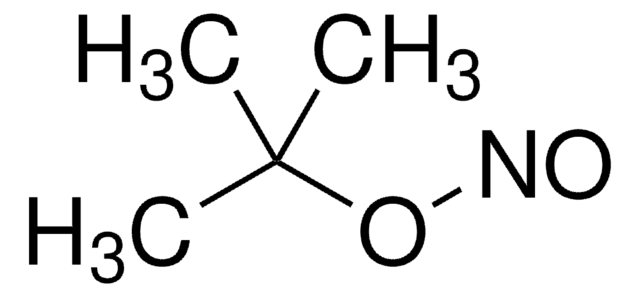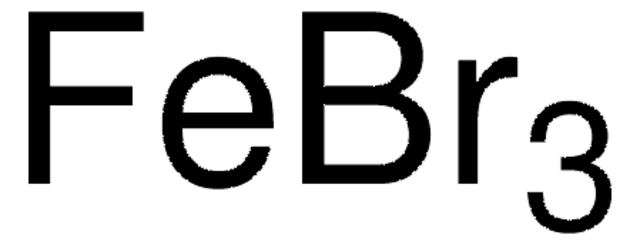221775
Copper(II) bromide
99%
Synonym(s):
brominating agent, Cupric bromide
Sign Into View Organizational & Contract Pricing
All Photos(4)
About This Item
Linear Formula:
CuBr2
CAS Number:
Molecular Weight:
223.35
EC Number:
MDL number:
UNSPSC Code:
12161600
eCl@ss:
38150112
PubChem Substance ID:
NACRES:
NA.22
Recommended Products
Quality Level
Assay
99%
form
solid
reaction suitability
core: copper
reagent type: catalyst
mp
498 °C (lit.)
density
4.77 g/mL at 25 °C (lit.)
SMILES string
Br[Cu]Br
InChI
1S/2BrH.Cu/h2*1H;/q;;+2/p-2
InChI key
QTMDXZNDVAMKGV-UHFFFAOYSA-L
Looking for similar products? Visit Product Comparison Guide
General description
Cuprous bromide may be prepared by the reduction of cupric bromide or CuSO4-NaBr. In the molten state, it is grayish brown /greenish brown in color.
Application
Some reported applications of copper bromide are:
Reductive homocoupling of α-bromo- α- chlorocarboxylates to dimethyl α, α′ dichlorosuccinate derivatives in presence of CuBr/LiOCH3 in methanol has been reported.
- catalyst in cross coupling reactions.
- co-catalyst in Sonogashira coupling.
- Lewis acid in enantioselective addition of alkynes.
- reducing agent, when complexed by three molecules of pyridine initiators for the controlled polymerization of styrene, methyl acrylate and methyl methacrylate.
Reductive homocoupling of α-bromo- α- chlorocarboxylates to dimethyl α, α′ dichlorosuccinate derivatives in presence of CuBr/LiOCH3 in methanol has been reported.
related product
Product No.
Description
Pricing
Signal Word
Danger
Hazard Statements
Precautionary Statements
Hazard Classifications
Acute Tox. 4 Oral - Aquatic Acute 1 - Aquatic Chronic 1 - Eye Dam. 1 - Skin Corr. 1B
Storage Class Code
8A - Combustible corrosive hazardous materials
WGK
WGK 3
Personal Protective Equipment
dust mask type N95 (US), Eyeshields, Gloves
Choose from one of the most recent versions:
Already Own This Product?
Find documentation for the products that you have recently purchased in the Document Library.
Customers Also Viewed
Jian Wang et al.
Macromolecular rapid communications, 40(2), e1800332-e1800332 (2018-06-28)
Polymerization-induced self-assembly (PISA) and in situ crosslinking of the formed nanoparticles are successfully realized by activators regenerated by electron-transfer atom transfer radical polymerization (ARGET ATRP) of glycidyl methacrylate (GMA) or a mixture of GMA/benzyl methacrylate (BnMA) monomers in ethanol. Poly(oligo(ethylene
Synthesis, 1535-1535 (2007)
Denissova I and Barriault L
Handbook of Reagents for Organic Synthesis null
Lu-Ying Han et al.
Pharmaceutics, 11(2) (2019-01-30)
Icariin (ICA) is a major flavonoid that contains the active compound Epimedii Folium. However, ICA's pharmacokinetic characteristics remain unsatisfactory due to its low bioavailability, and hence limited drugability. In order to improve its pharmacokinetics and achieve prolonged blood circulation time
Yu Wang
Polymers, 11(8) (2019-07-31)
Atom transfer radical polymerization (ATRP) of methyl acrylate (MA) was carried out by continuous feeding of Cu(I) activators. Typically, the solvent, the monomer, the initiator, and the CuBr2/Me6TREN deactivator are placed in a Schlenk flask (Me6TREN: tris[2-(dimethylamino)ethyl]amine), while the CuBr/Me6TREN
Our team of scientists has experience in all areas of research including Life Science, Material Science, Chemical Synthesis, Chromatography, Analytical and many others.
Contact Technical Service

![Tris[2-(dimethylamino)ethyl]amine 97%](/deepweb/assets/sigmaaldrich/product/structures/695/792/ee0ff167-22a3-43a7-83a1-6c4908adf0ae/640/ee0ff167-22a3-43a7-83a1-6c4908adf0ae.png)










